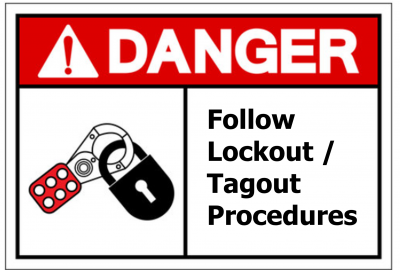 In the world of industrial and workplace safety, “Lockout Tagout” (LOTO) stands as a crucial procedure that safeguards workers from potentially life-threatening accidents caused by the unexpected release of hazardous energy sources. This comprehensive safety protocol serves as a vital protective measure, aiming to prevent machinery or equipment from powering on or moving during maintenance, repairs, or servicing. Understanding the significance of Lockout Tagout is essential for employers and employees alike, as it not only preserves lives but also ensures compliance with regulatory standards to maintain a secure working environment.
In the world of industrial and workplace safety, “Lockout Tagout” (LOTO) stands as a crucial procedure that safeguards workers from potentially life-threatening accidents caused by the unexpected release of hazardous energy sources. This comprehensive safety protocol serves as a vital protective measure, aiming to prevent machinery or equipment from powering on or moving during maintenance, repairs, or servicing. Understanding the significance of Lockout Tagout is essential for employers and employees alike, as it not only preserves lives but also ensures compliance with regulatory standards to maintain a secure working environment.
What is lockout tagout?
Lockout Tagout (LOTO) is a safety procedure used in industrial settings to protect workers from hazardous energy sources while performing maintenance, repairs, or servicing on machinery or equipment. The primary purpose of Lockout Tagout is to prevent unexpected startup or release of stored energy, such as electrical, mechanical, hydraulic, pneumatic, chemical, or thermal energy, which could cause injury or even death to workers.
During a Lockout Tagout procedure, authorized personnel apply locks or tags to energy isolation points of the machinery or equipment. Locks physically prevent the machinery from being energized, while tags provide a visual warning that the equipment is under maintenance and must not be operated.
The process involves several steps, including identifying energy sources, isolating the equipment, applying locks and tags, releasing any residual energy, and verifying that the system is in a safe state before commencing work. Proper training and adherence to Lockout Tagout protocols are essential to ensure worker safety and prevent accidents in industrial environments.
The Importance of LOTO Safety
With the continuous advancement of industrial processes and the introduction of increasingly sophisticated machinery, specialized maintenance procedures became a necessity. However, this progress also brought about a higher risk of accidents, particularly concerning the maintenance of energized systems. In the evolving landscape of industrial safety, incidents involving powerful machinery highlighted the critical need for a robust Lockout Tagout (LOTO) safety approach. Recognizing this imperative, the American National Standards Institute (ANSI) took the initiative in 1982 to provide guidance on LOTO practices, aimed at safeguarding workers from hazardous energy sources. Subsequently, in 1989, the Occupational Safety and Health Administration (OSHA) formalized LOTO guidelines into regulations, reinforcing the commitment to preserving lives and preventing injuries in the workplace. In this article, we delve into the significance of LOTO safety, its evolution as a standard practice, and its pivotal role in mitigating potential risks in industrial settings.
OSHA Guidelines: Safeguarding Against Hazardous Energy
The comprehensive guidelines set forth by the Occupational Safety and Health Administration (OSHA) encompass a wide range of energy sources, including mechanical, electrical, hydraulic, pneumatic, chemical, and thermal elements. In the dynamic environment of manufacturing plants, maintenance activities often involve handling one or more of these energy sources.
The essence of Lockout Tagout (LOTO), as implied by its name, lies in two primary approaches that ensure employee safety during maintenance operations: lockout and tagout. Lockout physically restricts access to specific equipment, rendering it inoperable during maintenance. On the other hand, tagout employs visible warning signs to alert employees about potential hazards, serving as a crucial reminder of the need for caution. By adhering to these OSHA-prescribed measures, organizations can effectively protect their workforce from dangerous equipment and create a safer working environment.
Understanding the Mechanics of Lockout Tagout (LOTO)
To ensure workplace safety, OSHA has established clear guidelines in Title 29 of the Code of Federal Regulations (CFR) Part 1910.147, focusing on the proper maintenance and servicing of equipment that could potentially release hazardous energy. Companies must identify equipment falling under these regulations to not only avoid penalties but, more importantly, prioritize the well-being of their workers.
To maintain compliance with federal LOTO standards during maintenance activities, a robust documentation process is essential. By integrating LOTO procedures into the Computerized Maintenance Management System (CMMS), companies can enhance visibility and track the progress of riskier tasks, offering an added layer of safety and control. Emphasizing LOTO protocols not only ensures adherence to regulations but also fosters a safer working environment, safeguarding employees from potential harm.
Safeguarding Workers: The Vital Steps of Lockout Tagout (LOTO)
Lockout Tagout (LOTO) is a critical safety procedure used to protect workers from hazardous energy sources during maintenance, repairs, or servicing of machinery or equipment. The steps involved in implementing LOTO may vary slightly depending on the specific equipment and workplace, but generally, the procedure involves the following key steps:
Preparation: Identify the machinery or equipment that requires servicing, maintenance, or repair. Notify all affected employees about the planned LOTO procedure and obtain the necessary permits.
Notify Affected Employees: Inform all employees who will be working on or near the equipment about the upcoming LOTO procedure. Clearly communicate the reason for the lockout and the expected duration of the procedure.
Shutdown: Turn off the equipment or machinery using the normal shutdown procedures. Follow the manufacturer’s guidelines and ensure that all controls are in the “off” position.
Isolation: Identify and isolate all energy sources that could potentially power the equipment. This may involve shutting off electrical switches, closing valves for hydraulic or pneumatic systems, blocking mechanical movements, and draining stored energy.
Application of Locks and Tags: Authorized personnel must apply lockout devices, such as padlocks, at each energy isolation point. Additionally, they should attach tags to indicate the reason for the lockout, the person responsible, and the expected completion time.
Release Stored Energy: After shutting down and isolating the equipment, verify that all sources of stored energy have dissipated. For example, release pressure from hydraulic or pneumatic systems and discharge capacitors in electrical systems.
Verification: Double-check that the equipment is in a safe state and cannot be energized. Attempt to start the machinery using the normal controls to ensure it remains inoperative.
Perform the Task: Once the equipment is locked out and verified safe, perform the required maintenance, repairs, or servicing.
Removal of Locks and Tags: When the task is complete, the employees who applied the locks and tags should be the ones to remove them. Before removal, ensure that all tools are clear, and everyone is safely positioned.
Reactivation: After the equipment has been serviced and the locks and tags have been removed, follow the appropriate procedures to reactivate the machinery safely.
Communication: Inform all employees that the lockout has been removed, and the equipment is back in operation.
Each step in the LOTO process is crucial, and strict adherence to these procedures helps prevent accidents, injuries, and fatalities caused by the unexpected release of hazardous energy during maintenance activities. Proper training and understanding of the specific equipment and energy sources are essential for the effective implementation of Lockout Tagout.
Essential Tools for Lockout Tagout (LOTO) Safety
Lockout Tagout (LOTO) safety tools encompass a variety of equipment designed to effectively implement the procedure and protect workers from hazardous energy sources. Some common LOTO devices include:
Padlocks: Sturdy padlocks are used to secure energy isolation devices, such as electrical switches, circuit breakers, valves, or pneumatic controls, in the off or closed position.
Lockout Hasps: Hasps are utilized to secure multiple padlocks, allowing multiple authorized individuals to lock out the same energy isolation point.
Lockout Tags: Tags provide a prominent visual warning that equipment is locked out and must not be operated. They typically contain essential information such as the reason for the lockout, the name of the authorized person, and the expected completion time.
Lockout Devices: Specialized lockout devices are designed to physically restrain and isolate specific energy isolation points, preventing the equipment from being reenergized during maintenance.
Circuit Breaker Lockouts: These devices are used to lock circuit breakers in the off position, preventing accidental or unauthorized reactivation of electrical circuits.
Valve Lockouts: Valve lockouts securely cover valve handles to prevent them from being opened, closed, or operated during maintenance.
Plug Lockouts: Used to secure electrical plugs, plug lockouts prevent them from being inserted into power outlets.
Electrical Lockout Devices: These tools block electrical connectors, switches, or outlets to prevent electrical hazards.
Pneumatic Lockout Devices: Used to lock pneumatic controls and prevent the release of compressed air during maintenance.
Additionally, tagout devices are employed as prominent warning tools that visibly identify the equipment as potentially hazardous. These can be in the form of signs or symbols securely attached to the equipment.
Non-physical tools like specialized software, such as CMMS, have been utilized to enhance LOTO processes’ efficiency. Tracking LOTO activities through maintenance management software proves advantageous in ensuring accurate compliance with standards and streamlining the overall safety procedures. As technology continues to evolve, integrating advanced software solutions further contributes to a safer work environment and reduces the risk of accidents related to hazardous energy sources.
Improving Workplace Safety: Mastering Lockout Tagout (LOTO) Procedures
Incorporating Lockout Tagout (LOTO) functionality into Computerized Maintenance Management Systems (CMMS) empowers organizations to efficiently manage LOTO procedures, enhance workplace safety, and promote a safer work environment. With CMMS, LOTO activities are documented and tracked in a centralized platform, enabling proper planning and scheduling of maintenance tasks. Real-time visibility into ongoing LOTO tasks allows supervisors to monitor progress and ensure compliance with safety regulations. By storing and analyzing historical LOTO data, CMMS facilitates continuous improvement of safety protocols. Furthermore, CMMS integration with employee training modules ensures that workers receive proper LOTO training and that certifications and qualifications are appropriately tracked. This technology-driven approach streamlines processes reinforces a commitment to safeguarding workers from hazardous energy sources, and fosters a culture of safety consciousness throughout the organization.
Lockout Tagout (LOTO): Safeguarding Workers and Preventing Accidents
Incident reports underscore the sobering reality that many maintenance tragedies could have been averted with the implementation of fundamental lockout/tagout processes. One such heart-wrenching incident occurred in 2012 when a 21-year-old temporary worker tragically lost his life on his first day due to a lack of proper LOTO precautions. This unfortunate event transpired when a palletizing machine was inadvertently switched on while he was engaged in cleaning tasks.
To ensure the well-being of employees and prevent avoidable harm, fostering a safety culture within a plant’s operations is of utmost importance. Emphasizing seemingly obvious processes, such as lockout/tagout, can significantly enhance workplace safety when consistently and conscientiously practiced. By adhering to LOTO protocols, organizations can take tangible steps toward creating a safer working environment and protecting their valued workforce
Conclusion
Implementing lockout/tagout procedures is a paramount step in ensuring the safety of workers, particularly when dealing with hazardous energy sources. Adhering to LOTO standards not only avoids potential fines but, more importantly, prevents injuries and even fatalities in the workplace. To achieve optimal safety, organizations should make the most of lockout and tagout devices, along with utilizing available software, to create a secure work environment where the well-being of employees is prioritized. By embracing these vital safety measures, businesses can cultivate a culture of safety consciousness and protect their most valuable asset – their workforce.
Want to know more? Discover how advanced CMMS solutions can optimize Lockout Tagout (LOTO) procedures and elevate workplace safety to new heights. For further information, feel free to contact us.
See What Our Customers Are Saying
Customer Testimonials – Read More
Disclaimer: The information provided in this article is intended for informational purposes only. It does not constitute professional advice, and readers are encouraged to consult with relevant experts or authorities for specific guidance and implementation of Lockout Tagout (LOTO) procedures in their respective workplaces. The author and publisher of this article are not liable for any actions taken based on the content presented herein.



